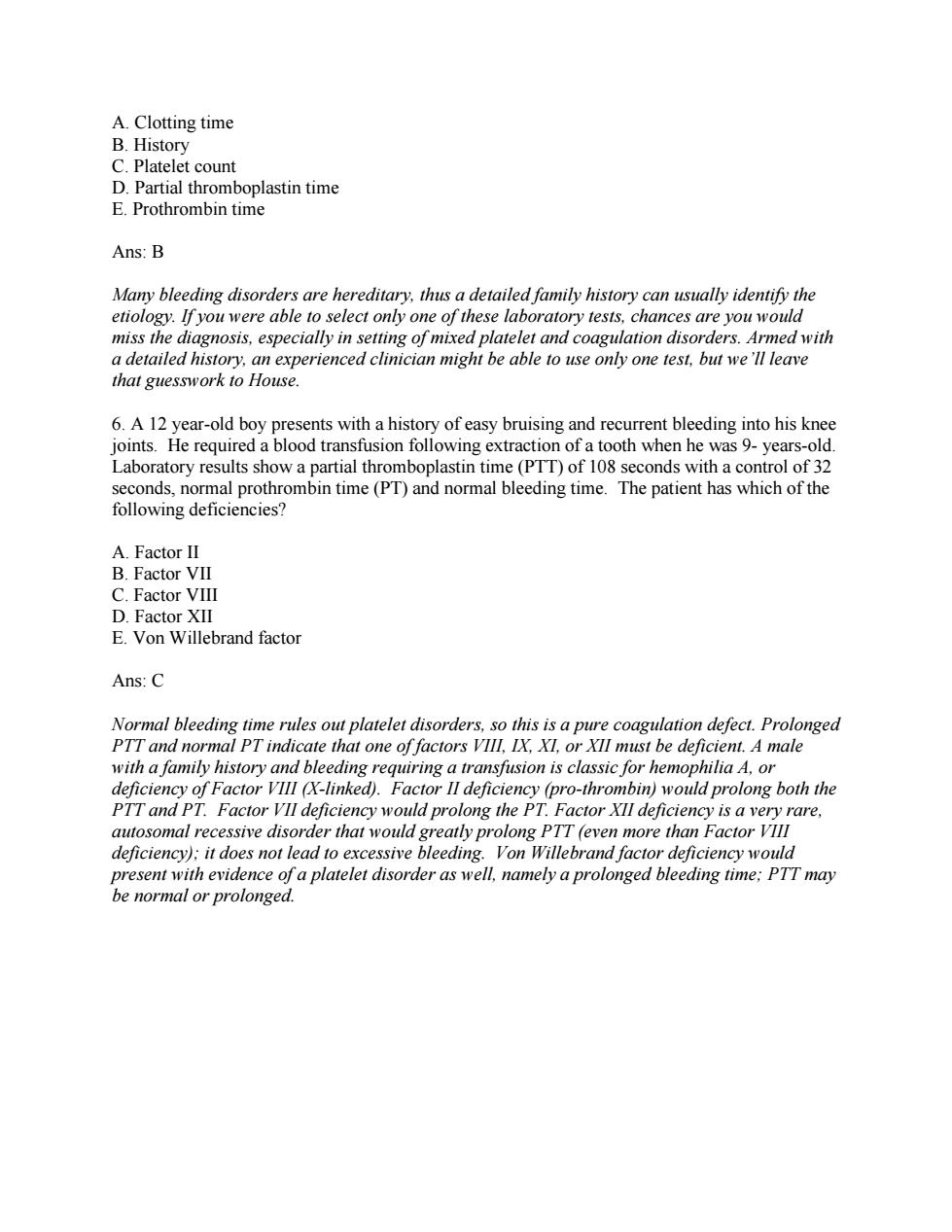正在加载图片...

A.Clotting time B.History C.Platelet count D.Partial thromboplastin time E Prothrombin time Ans:B Many bleeding disorders are hereditary,thus a detailed family history can usually identify the etiology.If you were able to select onl ne of these laboro uld miss the di nlatelet dis med with detailed his to use only one test.but we'll leave that guesswor House chinician might be 6.A 12 year-old boy presents with a history of easy bruising and recurrent bleeding into his kne joints.He required a blood transfusion following extraction of a tooth when he was 9-years-old Laboratory results show a partial thromboplastin time(PTT)of 108 seconds with a control of 32 seconds,normal prothrombin time(PT)and normal bleeding time.The patient has which of the following deficiencies? A.Factor II B.Factor VII C.Factor VIII D.Factor XII E.Von Willebrand factor Ans:C Normal bleeding time rules ors Vill.IX.XI defect.Prolonged st be eficie with a famil 20 sfusion is clas sic jo A.O ency (pro-tnror ong both the ncy would prolong the xII defic s a very tosomal rec sive disord r that would reatly prolong more in deficiency):it d es not lead to exce eeding. deficiency woula present with evidence of a platelet disorder as well,namely a prolonged bleeding time:PTT may be normal or prolongedA. Clotting time B. History C. Platelet count D. Partial thromboplastin time E. Prothrombin time Ans: B Many bleeding disorders are hereditary, thus a detailed family history can usually identify the etiology. If you were able to select only one of these laboratory tests, chances are you would miss the diagnosis, especially in setting of mixed platelet and coagulation disorders. Armed with a detailed history, an experienced clinician might be able to use only one test, but we’ll leave that guesswork to House. 6. A 12 year-old boy presents with a history of easy bruising and recurrent bleeding into his knee joints. He required a blood transfusion following extraction of a tooth when he was 9- years-old. Laboratory results show a partial thromboplastin time (PTT) of 108 seconds with a control of 32 seconds, normal prothrombin time (PT) and normal bleeding time. The patient has which of the following deficiencies? A. Factor II B. Factor VII C. Factor VIII D. Factor XII E. Von Willebrand factor Ans: C Normal bleeding time rules out platelet disorders, so this is a pure coagulation defect. Prolonged PTT and normal PT indicate that one of factors VIII, IX, XI, or XII must be deficient. A male with a family history and bleeding requiring a transfusion is classic for hemophilia A, or deficiency of Factor VIII (X-linked). Factor II deficiency (pro-thrombin) would prolong both the PTT and PT. Factor VII deficiency would prolong the PT. Factor XII deficiency is a very rare, autosomal recessive disorder that would greatly prolong PTT (even more than Factor VIII deficiency); it does not lead to excessive bleeding. Von Willebrand factor deficiency would present with evidence of a platelet disorder as well, namely a prolonged bleeding time; PTT may be normal or prolonged